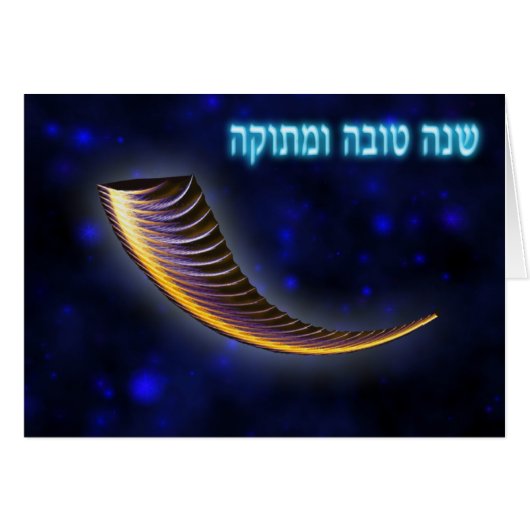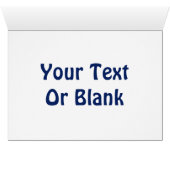
Sale Price $2.92.
Original Price $4.16 Comp. value
per card
You save 30%
Fractal Shofar - Rosh Hashanah
View Product DetailsAbout Cards
Sold by
About This Design
Fractal Shofar - Rosh Hashanah
Features a fractal rendering of a shofar (ram's horn) superimposed on a starry background image. The predominate colors are yellow, white and blue. Hebrew text reading, "שנה טובה ומתוקה" (Shanah tovah umetuka - Have a Good And Sweet Year) also appears in glowing blue and white. A shofar is made from the horn of a ram or other kosher animal. It was used in ancient Israel to announce the New Moon (Rosh Chodesh) and call people together. It was also blown on Rosh Hashanah, marking the beginning of the New Year, signifying both need to wake up to the call to repentance, and in connection with the portion read on the second day of Rosh Hashanah, the Binding of Isaac (Genesis, chapter 22) in which Abraham sacrifices a ram in place of his son, Isaac. The shofar is often mentioned in the Tanach, Talmud and in rabbinic literature. It was used to announce the start of holidays, in processions and even to mark the start of a war. Perhaps the most famous biblical reference to the shofar occurs in the Book of Joshua, where shofarot (plural of shofar) were used to capture the city of Jericho. The shofar was blown and the Jews were able to capture the city. The shofar was commonly taken out to war so the troops would know when a battle would begin. The person who would blow the shofar would call out to the troops from atop a hill. All of the troops were able to hear the call of the shofar from their position because of its distinct sound. "Then the LORD said to Joshua… March around the city once with all the armed men. Do this for six days. Have seven priests carry trumpets of rams' horns in front of the ark. On the seventh day, march around the city seven times, with the priests blowing the trumpets. When you hear them sound a long blast on the trumpets, have all the people give a loud shout; then the wall of the city will collapse and the people will go up, every man straight in. (Joshua 6:2-5)" In the Temple in Jerusalem, the shofar was sometimes used together with the trumpet. On New Year's Day the principal ceremony was conducted with the shofar, which instrument was placed in the center with a trumpet on either side; it was the horn of a wild goat and straight in shape, being ornamented with gold at the mouthpiece. On fast days the principal ceremony was conducted with the trumpets in the center and with a shofar on either side. On those occasions the shofarot were rams' horns curved in shape and ornamented with silver at the mouthpieces. On Yom Kippur of the jubilee year the ceremony was performed with the shofar as on New Year's Day. Rosh Hoshana is the Jewish New Year. A ceremonial horn, called a “shofar” is blown, reminding Jews that God is king. A feast with symbolic food is eaten on Rosh Hashana, and the next ten days are spent in repentance. Rosh Hashana ends on Yom Kippur. Yom Kippur is a day of judgment, during which prayers are made asking for forgiveness. On Rosh Hashanah and other full holidays (Day of Atonement, Ingathering of the harvest [Succot], Passover and the Feast of Weeks – Pentecost) a single Priest perfected two sacrifices in honor of the full holiday, On Rosh Hashanah, something special occurred during the special sacrifice. Arguably two Shofar Sounders played the long notes and one Trumpet player played the short note. Accordingly, Rosh HaShanah is called Yom Teruah (the day of the blast) Otherwise, the Trumpets had “top billing.” Rosh Hashanah27a, supports this claim: “Said Raba or it may have been R. Joshua B. Levi: What is the scriptural warrant for this? – Because it is written, “With trumpets and the sound of the Shofar shout ye before the King in the Temple, we require trumpets and the sound of the Shofar; elsewhere not.” Rosh Hashanah announced the jubilee year, and the sound of the shofar on Yom Kippur proclaimed the actual release of financial encumbrances. In post-Biblical times, the shofar was enhanced in its religious use because of the ban on playing musical instruments as a sign of mourning for the destruction of the temple. The shofar continues to announce the New Year and the new moon, to introduce Shabbat, to carry out the commandment to sound it on Rosh Hashanah, and to mark the end of the day of fasting on Yom Kippur once the services have completed in the evening. The secular uses have been discarded (although the shofar was sounded to commemorate the reunification of Jerusalem in 1967) Today the shofar is primarily associated with Rosh Hashanah. (meaning “head of the year” in Hebrew) and and Yom Kippur. The shofar is such an important part of Rosh Hashanah that another name for the holiday is Yom Teruah (“day of the shofar blast”). The shofar is blown one hundred times on each of the two days of Rosh HaShanah. If one of the days of Rosh HaShanah falls on Shabbat, however, the shofar is not blown. According to the famous Jewish philosopher Maimonides, the sound of the shofar on Rosh HaShanah is meant to wake up soul and turn its attention to the important task of repentance (teshuvah). It is a commandment to blow the shofar on Rosh HaShanah and there are four specific shofar blasts associated with this holiday: Teki’ah – An unbroken blast lasting about three seconds Shva’rim – A teki’ah broken into three segments Teruah – Nine rapid fire blasts Tekiah Gedolah – A triple teki’ah lasting at least nine seconds, though many shofar blowers will attempt to go significantly longer, which the audience loves. The person who blows the shofar is called a Tokea (which literally means “blaster”) and it is no easy task to perform each of these sounds. Scroll down to the end of this article for a link to a video demonstrating the four shofar sounds of Rosh HaShanah. There is a great deal of symbolism tied in with the shofar and the legal requirements for what constitutes a proper shofar. The shofar of Rosh Hashanah, whose purpose it is to rouse the Divine in the listener, may not be constructed of an artificial instrument. It must be an instrument in its natural form and naturally hollow, through whom sound is produced by human breath, which God breathes into human beings. This pure, and natural sound, symbolizes the lives it calls Jews to lead. What is more, the most desirable shofar is the bent horn of a ram. The ram reminds one of Abraham's willing sacrifice of that which was most precious to him. The curve in the horn mirrors the contrition of the one who repents. The sounding of the shofar recounts the Akedah, when God asked Abraham to sacrifice Isaac. The story (Genesis 22:1-24) culminates with Abraham raising the knife to slay his son only to have God stay his hand and bring his attention to a ram caught in a nearby thicket. Abraham sacrificed the ram instead. Because of this story some midrashim claim that whenever the shofar is blown God will remember Abraham’s willingness to sacrifice his son and will therefore forgive those who hear the shofar’s blasts. In this way, just as the shofar blasts remind us to turn our hearts towards repentance, they also remind God to forgive us for our trespasses. The shofar is also associated with the idea of crowning God as King on Rosh HaShanah. The breath used by the Tokea to make the sounds of the shofar are also associated with the breathe of life, which God first breathed into Adam upon the creation of humanity. In practice two species are generally used: the Ashkenazi and Sefardi shofar is made from the horn of a domestic ram, while a Yemeni shofar is made from the horn of a kudu. A Moroccan Shofar is a flat Shofar with no curves besides the main curve; years ago, when the Morrocan Jews were not allowed to practice Judaism, it was easy to hide it in their clothes because of its flat shape.Jewish cemetery on the nearby Mount of Olives.
Customer Reviews
4.9 out of 5 stars rating7.3K Total Reviews
7,325 Reviews
Reviews for similar products
5 out of 5 stars rating
By K N.November 10, 2018 • Verified Purchase
Folded Card, Size: Standard (5" x 7"), Paper: Signature Matte
Creator Review
What strikes me most about this card on opening the envelope is the stunning color and the beautiful close up. The card itself lends it to a feel good touch as well so its a lot of senses perked! My customers like it as well! The color is stunning! The closeup is very nicely detailed and just perfectly awesome! Could not ask for better printing!
5 out of 5 stars rating
By NavinJOSHI s.August 13, 2013 • Verified Purchase
Folded Card, Size: Standard (5" x 7"), Paper: Signature Matte
Creator Review
Unusual color scheme is clearly visible on the art. Not many artist try to emphasize that as an artist they can see things different so long they look beautiful. This is an UNIQUE image.
I bought a bunch of 34 different cards as like to give a different card to each of my friend which makes it very personal. When friends talk with each other, they appreciate the gesture all the more. Also I took advantage of volume pricing. Thanks to Zazzle for allowing to order even one card. I recommend people to buy from Zazzle. Pure Joy. Excellent printing and color tones.
5 out of 5 stars rating
By K N.November 10, 2018 • Verified Purchase
Folded Card, Size: Standard (5" x 7"), Paper: Signature Matte
Creator Review
iI am overjoyed and tickled pin with this card!! he minute I oened the envelope and saw it it just raised my spirits! Love the feel of the paper, its high quality all the way! And my customer really appreciaed it!! And topping that paired up with the labels was a perfect match! The color and the entire card and design is perfect! Better than I hoped and so awesome! My customer appreciiated it too! And the labels matched in color perfecty too!
Tags
Other Info
Product ID: 137932685817341910
Created on: 9/25/2018, 12:18 AM
Rating: G
Recently Viewed Items



